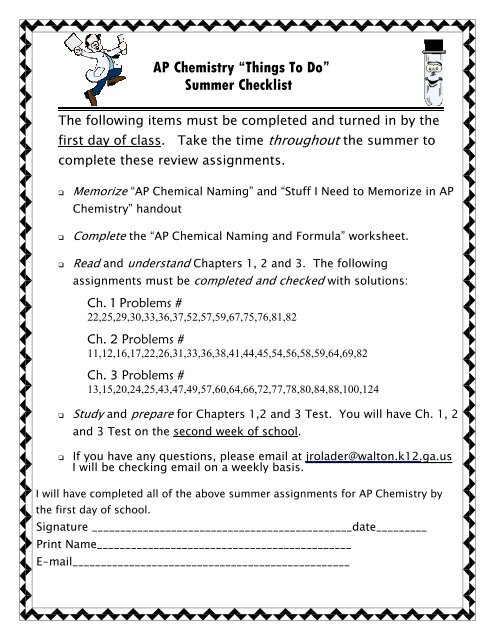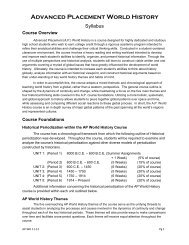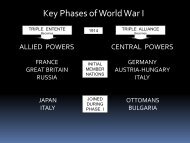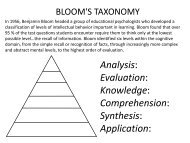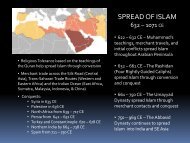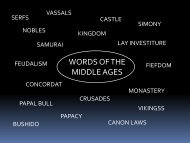AP Chemistry “Things To Do” Summer Checklist
AP Chemistry “Things To Do” Summer Checklist
AP Chemistry “Things To Do” Summer Checklist
Create successful ePaper yourself
Turn your PDF publications into a flip-book with our unique Google optimized e-Paper software.
<strong>AP</strong> <strong>Chemistry</strong> <strong>“Things</strong> <strong>To</strong> <strong>Do”</strong><br />
<strong>Summer</strong> <strong>Checklist</strong><br />
The following items must be completed and turned in by the<br />
first day of class. Take the time throughout the summer to<br />
complete these review assignments.<br />
Memorize “<strong>AP</strong> Chemical Naming” and “Stuff I Need to Memorize in <strong>AP</strong><br />
<strong>Chemistry</strong>” handout<br />
Complete the “<strong>AP</strong> Chemical Naming and Formula” worksheet.<br />
Read and understand Chapters 1, 2 and 3. The following<br />
assignments must be completed and checked with solutions:<br />
Ch. 1 Problems #<br />
22,25,29,30,33,36,37,52,57,59,67,75,76,81,82<br />
Ch. 2 Problems #<br />
11,12,16,17,22,26,31,33,36,38,41,44,45,54,56,58,59,64,69,82<br />
Ch. 3 Problems #<br />
13,15,20,24,25,43,47,49,57,60,64,66,72,77,78,80,84,88,100,124<br />
Study and prepare for Chapters 1,2 and 3 Test. You will have Ch. 1, 2<br />
and 3 Test on the second week of school.<br />
If you have any questions, please email at jrolader@walton.k12.ga.us<br />
I will be checking email on a weekly basis.<br />
I will have completed all of the above summer assignments for <strong>AP</strong> <strong>Chemistry</strong> by<br />
the first day of school.<br />
Signature ______________________________________________date_________<br />
Print Name_____________________________________________<br />
E-mail_________________________________________________
Common Ions<br />
CATIONS<br />
+1 +2 +3<br />
+<br />
ammonium NH4 2+<br />
cadmium(II) Cd<br />
3+<br />
cobalt(III) (blue) Co<br />
copper(I) (green) Cu + chromium(II) Cr 2+ chromium (III) Cr 3+<br />
hydronium H3O + copper(II) (blue) Cu 2+ iron(III) Fe 3+<br />
silver Ag + cobalt(II) (blue) Co 2+ lead(III) Pb 3+<br />
iron(II) Fe 2+ nickel(III) Ni 3+<br />
lead(II) Pb 2+ vanadium(III) V 3+<br />
2+<br />
mercury(I) Hg2 mercury(II) Hg 2+<br />
manganese(II) Mn 2+<br />
+4 nickel(II) (green) Ni 2+ +7<br />
tin(IV) Sn 4+ tin(II) Sn 2+ manganese(VII) Mn 7+<br />
lead(IV) Pb 4+ vanadium(II) V 2+<br />
vanadium(IV) V 4+ zinc Zn 2+<br />
ANIONS<br />
1- 2- 3-<br />
acetate CH3COO −<br />
2-<br />
carbonate CO3 3-<br />
phosphite PO3<br />
−<br />
C2H3O2 hypobromite BrO − chromate (yellow) CrO4 2- 3-<br />
phosphate PO4 −<br />
bromite BrO2 arsenate AsO4 3-<br />
−<br />
bromate BrO3 −<br />
perbromate BrO4 hypochlorite ClO − 2-<br />
dichromate (orange) Cr2O7 −<br />
chlorite ClO2 hydrogen phosphate HPO4 2-<br />
−<br />
chlorate ClO3 2-<br />
oxalate C2O4 −<br />
perchlorate ClO4 peroxide O2 2-<br />
cyanide CN − sulfite SO3 2-<br />
−<br />
dihydrogen phosphate H2PO4 sulfate SO4 2-<br />
formate HCOO − −<br />
hydrogen carbonate HCO3 (bicarbonate)<br />
−<br />
hydrogen sulfite HSO3 (bisulfite)<br />
−<br />
hydrogen sulfate HSO4 (bisulfate)<br />
bisulfide HS<br />
2-<br />
thiosulfate S2O3 −<br />
hydroxide OH −<br />
−<br />
nitrite NO2 −<br />
nitrate NO3 hypoiodite IO −<br />
iodite IO2 −<br />
−<br />
iodate IO3 −<br />
periodate IO4 −<br />
permanganate (purple) MnO4 thiocyanate SCN −<br />
STUFF I Need to Memorize in <strong>AP</strong> <strong>Chemistry</strong><br />
Solubility Rules of Common Ionic Compounds in Water at 25°C<br />
Soluble Compounds Exceptions<br />
alkali metals (H + , Li + , Na + , K + , Rb + , Cs + )<br />
ammonium ion (NH 4 + )<br />
nitrates (NO 3 ─ ), bicarbonates (HCO3 ─ ),<br />
chlorates (ClO3 ─ ), perchlorates (ClO 4 ─ ),<br />
acetates (CH 3COO ─ )<br />
halides (Cl ─ , Br ─ , I ─ )<br />
fluorine ion (F ─ )<br />
2─<br />
sulfates (SO4 )<br />
Polyatomic Elements<br />
(Diatomic)<br />
hydrogen H2<br />
nitrogen N2<br />
oxygen O2<br />
fluorine F2<br />
chlorine Cl2<br />
bromine Br2<br />
iodine I2<br />
astatine At2<br />
phosphorus P4<br />
sulfur S8<br />
oxone O<br />
Ag + 2+ 2+<br />
, Hg2 and Pb (<strong>AP</strong>H)<br />
Pb 2+ , Ca 2+ , Sr 2+ ,Ba 2+ and Mg 2+ (CBS/PM)<br />
Ag + 2+ 2+ 2+ 2+ 2+<br />
, Hg2 , Pb , Ca , Sr and Ba<br />
Insoluble Compounds Exceptions<br />
2─ 2─<br />
carbonates (CO3 ), chromates (CrO4 ),<br />
2─ 2─<br />
oxalate (C2O4 ),sulfides (S ),<br />
sulfites (SO3 2─ 3─<br />
), phosphates (PO4 ),<br />
alkali metal ions and NH4 +<br />
hydroxides (OH ─ ) and peroxides (O 2 2─ )<br />
8 Strong Acids (H + )<br />
(all other acids are weak)<br />
hydrochloric acid HCl<br />
hydrobromic acid HBr<br />
hydroiodic acid HI<br />
perchloric acid HClO4<br />
chloric acid HClO3<br />
nitric acid HNO3<br />
periodic acid HlO4<br />
sulfuric acid H2SO4<br />
alkali metal ions and NH 4 +<br />
*Ca 2+ , *Sr 2+ and Ba 2+ (CBS)<br />
Metric Prefixes<br />
kilo- k 10 3<br />
deci- d 10 −1<br />
centi- c 10 −2<br />
milli- m 10 −3<br />
micro- µ 10 −6<br />
nano- n 10 −9<br />
(CBS/<strong>AP</strong>H)<br />
8 Strong Bases (OH − )<br />
(all other bases are weak)<br />
lithium hydroxide LiOH<br />
sodium hydroxide NaOH<br />
potassium hydroxide KOH<br />
rubidium hydroxide RbOH<br />
cesium hydroxide CsOH<br />
calcium hydroxide *Ca(OH)2<br />
strontium hydroxide *Sr(OH)2<br />
barium hydroxide Ba(OH)2<br />
*Limited solubility
IONIC compound<br />
(metal + nonmetal)<br />
1) name the first element. Use roman<br />
numerals for d-block metals with<br />
more than 1 one oxidation number.<br />
2) name the second element with the<br />
–ide ending<br />
Ex: NaCl – sodium chloride<br />
CuCl2 – copper(II) chloride<br />
d-block metals:<br />
Cr 2+ , Cr 3+ , Cu 1+ , Cu 2+ , Co 2+ , Co 3+ , Fe 2+ , Fe 3+ ,<br />
Pb 2+ , Pb 3+ , Pb 4+ , Mn 2+ , Mn 7+ , Hg 2+ , Hg2 2+ ,<br />
Ni 1+ , Ni 2+ , Sn 2+ , Sn 4+ , V 2+ , V 3+ , V 4+<br />
ACID<br />
(compound beginning with hydrogen)<br />
1) hydrogen + halogen<br />
a) name hydro- for H atom<br />
b) replace the –ine ending of the<br />
halogen with –ic ending<br />
c) add the word acid<br />
Ex: HCl – hydrochloric acid<br />
2) hydrogen + polyatomic ion<br />
a) polyatomic ion has ending:<br />
replace –ate with –ic<br />
replace –ite with -ous<br />
b) add the word acid<br />
Ex: H2SO4 – sulfuric acid<br />
H2SO3 – sulfurous acid<br />
<strong>AP</strong> CHEMICAL NAMING<br />
COVALENT compound<br />
(nonmetal + nonmetal)<br />
1) name the first element using the<br />
proper prefix (never use mono-)<br />
2) name the second element using the<br />
proper prefix with the –ide ending<br />
Ex: NO – nitrogen monoxide<br />
N2O5 – dinitrogen pentoxide<br />
Prefixes:<br />
1 2 3 4 5 6 7 8 9 10<br />
mono di tri tetra penta hexa hepta octa nano deca<br />
ORGANIC compound including Hydrocarbons<br />
(compounds containing any of the following elements: C, O, H, N)<br />
1) identify compound as: Alkanes (all single bonds) = CnH2n+2 Ex: CH4 – methane<br />
Alkenes (at least 1 double bond)= CnH2n Ex: C3H6 – propene<br />
Alkynes (at least 1 triple bond)= CnH2n―2 Ex: C2H2 – ethyne<br />
(commonly known as acteylene)<br />
2) using the proper prefix to represent the number of CARBON atoms in the compound.<br />
3) if compound has an alcohol group (-OH), use the –ol ending. Ex: C4H9OH – butanol<br />
Prefixes according to the # of CARBON atoms:<br />
1 2 3 4 5 6 7 8 9 10 12 17<br />
meth eth prop but pent hex hept oct non dec dodec heptadec<br />
compound w/ POLYATOMIC ION<br />
(metal or nonmetal + polyatomic ion)<br />
1) use the rules for naming ionic<br />
compounds<br />
2) never modify the special name of<br />
the polyatomic ion<br />
Ex: NaHCO3 – sodium bicarbonate<br />
NH4Cl – ammonium chloride<br />
Fe(NO3)3 – iron (III) nitrate<br />
short-cuts:<br />
sulfate (SO4 2- ) – -ate ending for<br />
polyatomic ions with more oxygen atoms<br />
sulfite (SO3 2- ) – -ite ending for ions with<br />
less oxygen atoms<br />
Ex: nitrate (NO3 ― ) nitrite (NO2 ― )
<strong>AP</strong> CHEMICAL NAMING and FORMULA Worksheet<br />
IONIC Compound<br />
Chemical Name Chemical Formula<br />
iron(III) phosphide<br />
NiSe<br />
lithium oxide<br />
nickel(I) bromide<br />
aluminum sulfide<br />
K2O<br />
lithium arsenide<br />
copper(II) oxide<br />
vanadium(III) selenide<br />
beryllium oxide<br />
strontium sulfide<br />
Pb3N4<br />
CaBr2<br />
Zn3N2<br />
Co2S3<br />
FeO<br />
AgCl<br />
BaCl2<br />
Mn2O7<br />
Cu2S<br />
POLYATOMIC Compound<br />
Chemical Name Chemical Formula<br />
sodium hydroxide<br />
ammonium sulfate<br />
cobalt(III) nitrate<br />
zinc phosphate<br />
copper(II) cyanide<br />
magnesium chlorate<br />
aluminum carbonate<br />
nickel(II) hydroxide<br />
Cu(CH3COO)2<br />
SnCr2O7<br />
KMnO4<br />
K2SO3<br />
Sn(OH)2<br />
H2O2<br />
Cr(NO2)3<br />
CoCO3<br />
CuHCO3<br />
Mn(NO3)7<br />
Ga2(SO4)3<br />
AgNO3<br />
COVALENT Compound<br />
Chemical Name Chemical Formula<br />
chlorine dioxide<br />
dinitrogen trisulfide<br />
phosphorus triiodide<br />
selenium hexafluoride<br />
sulfur tetrachloride<br />
nitrogen trifluoride<br />
dinitrogen monoxide<br />
dinitrogen tetroxide<br />
SbBr3<br />
IF5<br />
N2O3<br />
NH3<br />
P4S5<br />
O2<br />
Si2Br6<br />
B2Si<br />
S2Cl2<br />
OF2<br />
Cl2O8<br />
SO3<br />
ACID<br />
Chemical Name Chemical Formula<br />
HBr<br />
CH3COOH<br />
nitric acid<br />
hypochlorous acid<br />
phosphoric acid<br />
hydrofluoric acid<br />
hydrochloric acid<br />
perchloric acid<br />
sulfurous acid<br />
bromic acid<br />
chlorous acid<br />
hydriodic acid<br />
HNO2<br />
HCN<br />
H2CO3<br />
HClO3<br />
H2SO4<br />
H2C2O4<br />
HF<br />
H2CrO4
ORGANIC Compound<br />
Chemical Name Chemical Formula<br />
butene<br />
pentane<br />
ethyne<br />
pentene<br />
hexyne<br />
octane<br />
propyne<br />
heptene<br />
heptadecyne<br />
methanol<br />
dodecanol<br />
<strong>AP</strong> CHEMICAL NAMING and FORMULA Worksheet<br />
C3H8<br />
C2H5OH<br />
C8H16<br />
C4H9OH<br />
C7H12<br />
C9H16<br />
C2H2<br />
C6H14<br />
C10H18<br />
CUMULATIVE<br />
Chemical Name Chemical Formula<br />
heptene<br />
phosphoric acid<br />
barium fluoride<br />
aluminum bicarbonate<br />
aluminum iodide<br />
iron(III) oxalate<br />
sulfuric acid<br />
nitrogen dioxide<br />
barium phosphate<br />
boron trichloride<br />
nitrogen gas<br />
copper(I) acetate<br />
propanol<br />
carbon monoxide<br />
ethyne<br />
diphosphorus pentoxide<br />
nitrous acid<br />
magnesium hydroxide<br />
NH4NO3<br />
Mg3P2<br />
MnO<br />
IO9<br />
PbCrO4<br />
ZnO<br />
CaH2<br />
SnO2<br />
C9C20<br />
N2H4<br />
HNO3<br />
C4H6<br />
CdF2<br />
Hg2Br2<br />
PI3<br />
Fe(CH3COO)3<br />
HCl<br />
CuCl<br />
KNO3<br />
Pb(SO3)2<br />
H2SO3<br />
NH4Cl<br />
K3PO4<br />
C5H12<br />
CH4


